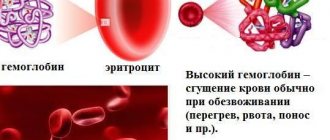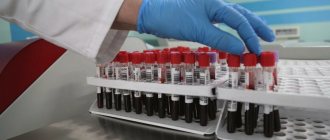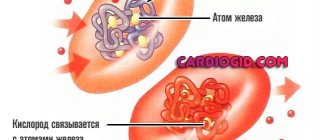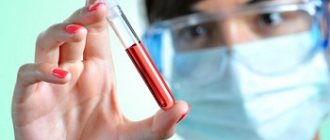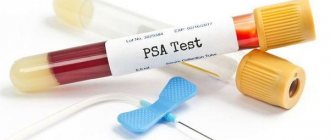" Blood tests
The level of hemoglobin can be used to judge the general condition of the human body and diagnose many diseases. As you know, for the average man this figure is higher than for women and ranges from 140 to 160 grams per liter. This is due primarily to the presence of the hormone testosterone in the body of the stronger half of humanity, as well as to a more active lifestyle. Meanwhile, if the above value is twenty units higher than the norm, then we can talk about an increased hemoglobin content and the person has health problems.
- 2 Diet and products
- 3 Traditional medicine for high hemoglobin
High hemoglobin - main symptoms
An increase in hemoglobin (hyperhemoglobinemia) can be detected using a blood test. But changes in blood viscosity also have external manifestations:
- general weakness and apathy, rapid fatigue;
- decreased attention, weakened memory;
— sleep disturbance, emotional swings;
- aching joints, muscle pain and headaches;
- loss of appetite (partial or complete);
- paleness of the fingertips;
- urination problems (increases frequency or becomes rare);
- yellow tint of the skin, itching; pigmentation of the palms and axillary area;
- yellowing of the palate, tongue, eye whites;
- feeling of thirst and dry mucous membranes;
- deterioration in vision clarity;
— change in pressure;
- Women may experience prolonged menstruation with severe pain.
As you can see, such symptoms can easily be confused with a number of other diseases. So, based on symptoms alone, it is extremely difficult to identify an excess of hemoglobin in the blood.
In most cases, the increase in hemoglobin is secondary. The primary condition here will be some kind of disease.
Consequences of increased blood viscosity
Increasing hemoglobin levels and increasing blood viscosity are interrelated concepts.
Moreover, either the concentration of protein bodies jumped, which means the blood became thicker, or the lack of fluid led to an increase in the thickness of the blood, which caused an increase in the degree of its saturation with hemoglobin structures.
These phenomena have a number of negative consequences for the body.
- Due to the high saturation of the blood with protein bodies, the likelihood of them sticking together increases. This is precisely the mechanism of thrombus formation.
- Thick blood moves more slowly through the vessels, which leads to the deposition of cholesterol and other “garbage” on the walls of the blood vessels. This leads to the formation of plaques and blockage of blood vessels.
- Blood that is too viscous requires a lot of effort to pump it. As a result, the load on the heart and the circulatory structures themselves increases sharply.
- Due to the low speed of blood movement, nutrition and gas exchange throughout the body deteriorate, and self-purification processes slow down. Poor blood circulation in the brain is fraught with mental disorders and many other complications.
- With long-term high levels of hemoglobin in children, developmental and growth disorders are observed.
Thus, increased hemoglobin in the blood of women and men can lead to congestion, heart attack, heart attacks, ischemia, and thrombosis.
These are serious disorders that are much easier to prevent than to try to cure. In addition, there is a considerable probability of death. It is enough for one large blood clot to simply break off and completely block the blood flow.
Diagnostics
The level of iron-containing protein in the blood is determined using a clinical blood test. Biological fluid for laboratory testing is taken from a finger or vein. Taking blood for Hb does not require any specific preparation. Donate blood in the morning on an empty stomach, preferably 8-12 hours after the last meal. If you feel very hungry, you can drink a few sips of clean water.
Attention! Often the test result is false positive. This is due to the individual characteristics of the body of men, who have a high concentration of red blood cells in the morning.
Only a specialist can give an accurate interpretation of the test results. If a high protein concentration is detected, the attending physician prescribes a comprehensive diagnostic examination individually for each patient.
Ways to reduce elevated hemoglobin in the blood - treatment
It should be clearly understood that the problem of increased hemoglobin is really serious. Therefore, there is no place for self-diagnosis or self-medication here. All techniques, including the proposed diet, must be discussed with a specialist.
But there is no need to panic either. Especially if the indicator is insignificantly overestimated and there is a high probability that this is a temporary phenomenon.
In this case, no special actions, much less treatment, are needed. Everything will return to normal on its own. The main thing is to determine which factor caused the unwanted jump in order to remove it or at least minimize its influence.
You should also avoid eating foods containing iron and vit. AT 9.
Otherwise, the hemoglobin level will continue to increase.
Taking iron-containing and complex vitamin preparations should be discontinued. But the doctor also makes similar conclusions. Perhaps taking vitamin supplements and folic acid will help solve the problem and normalize the condition.
Also, an increase in hemoglobin can be caused by some other medications.
Hemoglobin can increase:
— hormonal drugs, including contraceptives;
- sedatives;
- medications that constrict blood vessels and normalize blood pressure.
You should inform your doctor about taking these medications. They may need to be abandoned or replaced with other drugs that are more appropriate in the circumstances.
Drug treatment
You should know that there are no drugs that specifically target hemoglobin. The action of the drugs is aimed at thinning the blood and normalizing its clotting.
Commonly used:
Trental - thins the blood and reduces aggregation phenomena.
Aspirin - half a tablet a day is enough, it is contraindicated for problems with the gastrointestinal tract.
Cardiomagnyl is an aspirin-based drug that also contains magnesium hydroxide, which eliminates the negative effect of the acidic component of the drug on the stomach.
Curantil - reduces thrombus formation, contraindicated in renal and heart failure and heart attack.
Warfarin - reduces clotting, is prescribed in parallel with aspirin, has many contraindications.
These pharmacological agents are prescribed only by a doctor. Occasionally, a special procedure may be prescribed - erythrocytapheresis.
It allows you to filter out excess hemoglobin structures. A course of 3-5 procedures is prescribed, one per week.
In cases where the increase in hemoglobin indicator has jumped due to the presence or exacerbation of a disease, then all efforts should be focused on curing it.
If this root cause is not eliminated, then all actions to reduce hemoglobin may be ineffective. These matters are also within the “jurisdiction” of the doctor. Only he is responsible for prescribing and discontinuing medications, as well as monitoring the patient’s condition.
All changes in health, especially negative ones, and side effects from prescribed medications should be reported to your doctor.
Without this, it is impossible to correctly adjust the treatment regimen and obtain quick results.
Treatment with diet
A special dietary menu will help avoid further increases in hemoglobin levels. As already noted, foods high in iron and vitamin content should be excluded from the daily diet. B9 (folic acid).
The menu should not contain products such as:
- meat, eggs, liver, sausages;
- radishes, beets, berries and fruits colored red and yellow-orange (especially pomegranates, cranberries and apples);
- milk and milk products with high fat content;
— sweets, baked goods and sweet drinks, alcoholic products, beer, including non-alcoholic beer, cocoa products;
- buckwheat and oatmeal porridge;
- nuts;
- mushrooms, especially dried ones;
- caviar.
You should also be wary of products that contain food additives. It would be advisable to refrain from fried foods.
But what can you eat then?
Allowed dishes based on:
- lean fish and seafood (shrimp, mussels, squid);
- chicken breast;
— vegetables and fruits (green color) and juices;
— fermented milk products (cheese, kefir, sour cream), as well as cottage cheese;
- legumes;
- sauerkraut;
- greenery.
It would be a good idea to switch to a vegetarian diet during treatment.
It is recommended to do a weekly “deload”, focusing on drinking juices, herbal infusions and purified water.
Prognosis and prevention
To prevent an increase in iron-containing protein in the blood and reduce further thickening of the blood, you need to follow simple preventive rules. Men should:
- eat properly and balanced;
- drink more clean water;
- stop smoking, alcohol;
- engage in only feasible sports;
- walk more in the fresh air;
- avoid emotional stress;
- observe a rest and wakefulness regime;
- take any medications only with the permission of a doctor;
- regularly donate blood for general analysis.
Age norms of hemoglobin
Normal hemoglobin levels vary depending on the age and gender of the patient. For men, this figure is slightly lower than for women. They are characterized by the following norms.
| Age | Norm, g/l |
| 3 months | 114 |
| 6 months | 117 |
| 1 year | 116 |
| 3 years | 118 |
| Teens and mature men | 135-160 |
Since the functions of hemoglobin are to transport oxygen, its level is very important for the proper functioning of the body. For female patients, the table looks like this.
| Age | Norm, g/l |
| 3 months | 115 |
| 6 months | 119 |
| 1 year | 118 |
| 3 years | 120 |
| Teens and mature women | 120-140 |
If normal values increase by 10 or more units, it is necessary to prescribe therapeutic therapy and a diet that allows you to restore balance in the blood composition. Neglecting your own health can cause the development of many complications and pathologies that could have been avoided with timely diagnosis and treatment.
Reasons for increased hemoglobin in men
Functional and pathological factors can influence hemoglobin levels. Normal physiological, adaptive and compensatory mechanisms operate under certain conditions of climate, altitude, latitude, etc.
These include:
Long-term presence and residence of a person in high mountain areas. Low atmospheric pressure causes a response from the body, which consists of deepening and increasing breathing in order to compensate for the lack of oxygen supply from the rarefied air. This is a short term reaction. Then a longer adaptive mechanism develops, which increases the number of red blood cells in the blood and, accordingly, hemoglobin. The duration of its formation is from a week to 2 months. After a transition period, breathing evens out and slows down again. The process plays a role in the development of mountain sickness in climbers. This unpleasant pathology develops in the case of a sharp rise to a high altitude without adaptation;
excessive physical stress. From a one-time load, the adaptive mechanisms of increased gas exchange will not have time to work, but if the overload lasts a long time, then the blood will react by increasing the number of red blood cells and the hemoglobin content. This reaction of the body aims to relieve the respiratory system and cardiovascular system. Therefore, often in men associated with constant heavy physical labor, hemoglobin numbers are higher than normal. A similar phenomenon occurs in athletes experiencing monotonous daily overload. For example, long-distance runners, cyclists, skiers, etc.
functional types of dehydration are intermediate between physiological and pathological causes of increased hemoglobin;- living in conditions with insufficient water. For example, working in a hot climate and without proper drinking conditions. In this case, an irreplaceable loss of fluid occurs, leading to “thickening” of the blood. These types of work are more typical for men, so functional dehydration is more common among them.
Please note: the longer a person works and lives in such conditions, the more hyperhemoglobinemia develops and the risk of complications increases.
An increase in hemoglobin in men can develop as a result of diseases:
- occurring with debilitating and prolonged diarrhea, especially accompanied by concomitant vomiting (infectious diseases);
- with excessive urination due to diabetes, chronic stress, kidney disease;
- chronic heart failure, causing swelling of the body and a compensatory increase in fluid secretion by the kidneys;
- malignant polycythemia vera (Vaquez disease).
Long-term use of diuretics and a number of other drugs, and deficiency of cyanocobalamin (vitamin B12) can lead to dehydration and thickening of the blood.
How to recognize deviations?
Symptoms associated with an increase in the amount of iron-containing protein vary from patient to patient. They depend on existing diseases. Sometimes there are no symptoms when the high hemoglobin content is not caused by physiological abnormalities.
With increased hemoglobin in a man, the following occurs:
- Regular thirst.
- Intense headaches that are difficult to relieve.
- Muscle weakness and rapid fatigue.
- Constant problems with sleep.
- Disturbances in heart rhythms.
- Loss of appetite.
- Decreased hearing and vision acuity.
- Abnormalities in bowel function (constipation or diarrhea).
Manifestations of increased hemoglobin also concern external changes. So the man’s skin will become hyperemic. Alternately with redness of the skin, it is observed that it turns pale and becomes dry and flaky.
Why does hemoglobin increase?
The level of hemoglobin can be influenced by one or several factors at once - the external environment, habits (diet, daily routine, nicotine), diseases that affect the composition of the blood. When moving to a new area where oxygen levels are low (high altitude), hemoglobin increases to adapt to the new conditions. Working conditions also greatly influence the state of the body - in workshops or mines with high air pollution and elevated temperatures, there is an excess of carbon dioxide, which provokes increased work of the circulatory system.
Those who work at heights - pilots, flight attendants, installers, rock climbers, rescuers - are periodically exposed to oxygen starvation, which increases the production of hemoglobin. The risk group also includes professional athletes - track and field athletes, wrestlers, skiers. And those who additionally use anabolic steroids or steroids when playing sports to build muscle mass or beautiful contours risk increasing the concentration of red blood cells and the level of hemoglobin. In addition to external factors, it is worth taking into account lifestyle - smoking, non-compliance with the drinking regime, eating salt in large quantities, passion for concentrates for cooking, all this also has a strong influence.
It is more difficult to determine the cause if it is caused by a malfunction of an organ or system that is not yet clearly manifested, these could be:
- asthma;
- gall bladder problems;
- oncology;
- diabetes;
- intoxication;
- pulmonary fibrosis;
- intestinal obstruction;
- pulmonary failure, renal, cardiac;
- heart disease;
- hyperactivity in children;
- an excess of vitamin B or iron (these components are included in different medications; replacement may be necessary to reduce their amount).
Temporary conditions such as stress, overwork, poor sleep or pregnancy also have an effect, but this is easier to resolve if you give the body a rest and spend some time under the supervision of a doctor.
In young children, blood thickening occurs when parents wrap the child up too much, are afraid of drafts, and do not provide sufficient access to oxygen. This may also be a consequence of complications of intrauterine maturation due to dysfunction of the placenta; over time, this will stabilize with proper care.
On a note!
In some cases, the peculiarity of blood thickness is inherited; if relatives have such a problem, it is useful to monitor your level in order to take timely measures.
